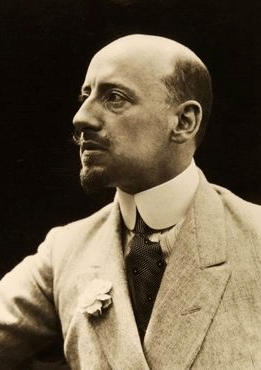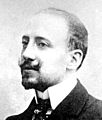Gabriele D’Annunzio facts for kids
Quick facts for kids
Gabriele D'Annunzio
|
|
|---|---|
 |
|
| Duce of the Carnaro | |
| In office 12 September 1919 – 30 December 1920 |
|
| Preceded by | Office created |
| Succeeded by | Office abolished (Riccardo Zanella as President of the Free State of Fiume) |
| Member of the Chamber of Deputies | |
| In office 5 April 1897 – 17 May 1900 |
|
| Constituency | Florence |
| Personal details | |
| Born | 12 March 1863 Pescara, Kingdom of Italy |
| Died | 1 March 1938 (aged 74) Gardone Riviera, Kingdom of Italy |
| Resting place | Vittoriale degli italiani, Gardone Riviera, Lake Garda |
| Political party | Historical Right (1897–1898) Historical Far-Left (1898–1900) Italian Nationalist Association (1910–1923) |
| Spouse |
Maria Hardouin
(m. 1883) |
| Domestic partner | Eleonora Duse (1898–1901) |
| Children |
|
| Parents | Francesco Paolo Rapagnetta and Luisa de Benedictis |
| Profession | Journalist, poet, soldier |
| Nicknames | "Il Vate" ("The Poet"); "Il Profeta" ("The Prophet") |
| Military service | |
| Branch/service | Royal Air Force |
| Years of service | active: 1915–18 |
| Rank | General (honorary) Lieutenant colonel Major Lieutenant colonel |
| Unit | 3rd Army Arditi |
| Battles/wars |
|
| Writing career | |
| Period | 20th century |
| Genre | Poetry, novel |
| Subject | Individualism, existentialism |
| Literary movement | Decadentism |
| Years active | 1879–1938 |
| Notable works |
|
| Signature | |
General Gabriele D'Annunzio (born March 12, 1863 – died March 1, 1938) was a famous Italian poet, writer, and soldier. He was also known as the Prince of Montenevoso and Duke of Gallese. People often called him Il Vate ("the Poet") or Il Profeta ("the Prophet").
D'Annunzio was a very important figure in Italian literature from the late 1800s to the early 1900s. Later, he became involved in politics. Some of his ideas and artistic styles influenced Italian fascism and leaders like Benito Mussolini.
His literary works were part of the Decadent movement. This style was connected to French Symbolism and British Aestheticism. These movements focused on beauty and emotions, moving away from simple realism. D'Annunzio was also influenced by the philosopher Friedrich Nietzsche.
Contents
A Hero in World War I
During World War I, Gabriele D'Annunzio became a national war hero in Italy. He joined the elite Arditi storm troops of the Italian Army. These were special forces known for their bravery.
Daring Air Missions
D'Annunzio took part in many exciting military actions. One of his most famous acts was the Flight over Vienna. In this mission, he flew over the city of Vienna. He dropped propaganda leaflets from his airplane. These leaflets encouraged the people of Vienna to surrender.
The Fiume Adventure
After World War I, there was a lot of disagreement about who should control certain territories. D'Annunzio was a strong Italian nationalist. He believed that the city of Fiume (now in Croatia) should belong to Italy.
Taking Control of Fiume
In September 1919, D'Annunzio led a group of soldiers and nationalists. They marched into Fiume and took control of the city. He then set up a new state called the Italian Regency of Carnaro. He called himself the Duce of this new state.
The Charter of Carnaro
The new state of Fiume had its own unique constitution. This constitution was very unusual. It declared that "music" was a fundamental principle of the state. The government also had a corporatist structure. This meant that different groups of workers and employers had a say in how the state was run. The Italian Regency of Carnaro was short-lived, lasting only until December 1920.
Images for kids
-
Fiume residents cheering D'Annunzio and his raiders, September 1919
-
Poster by Adolfo De Karolis for Alberto Franchetti's opera La figlia di Iorio (1906)
See also
 In Spanish: Gabriele D'Annunzio para niños
In Spanish: Gabriele D'Annunzio para niños












